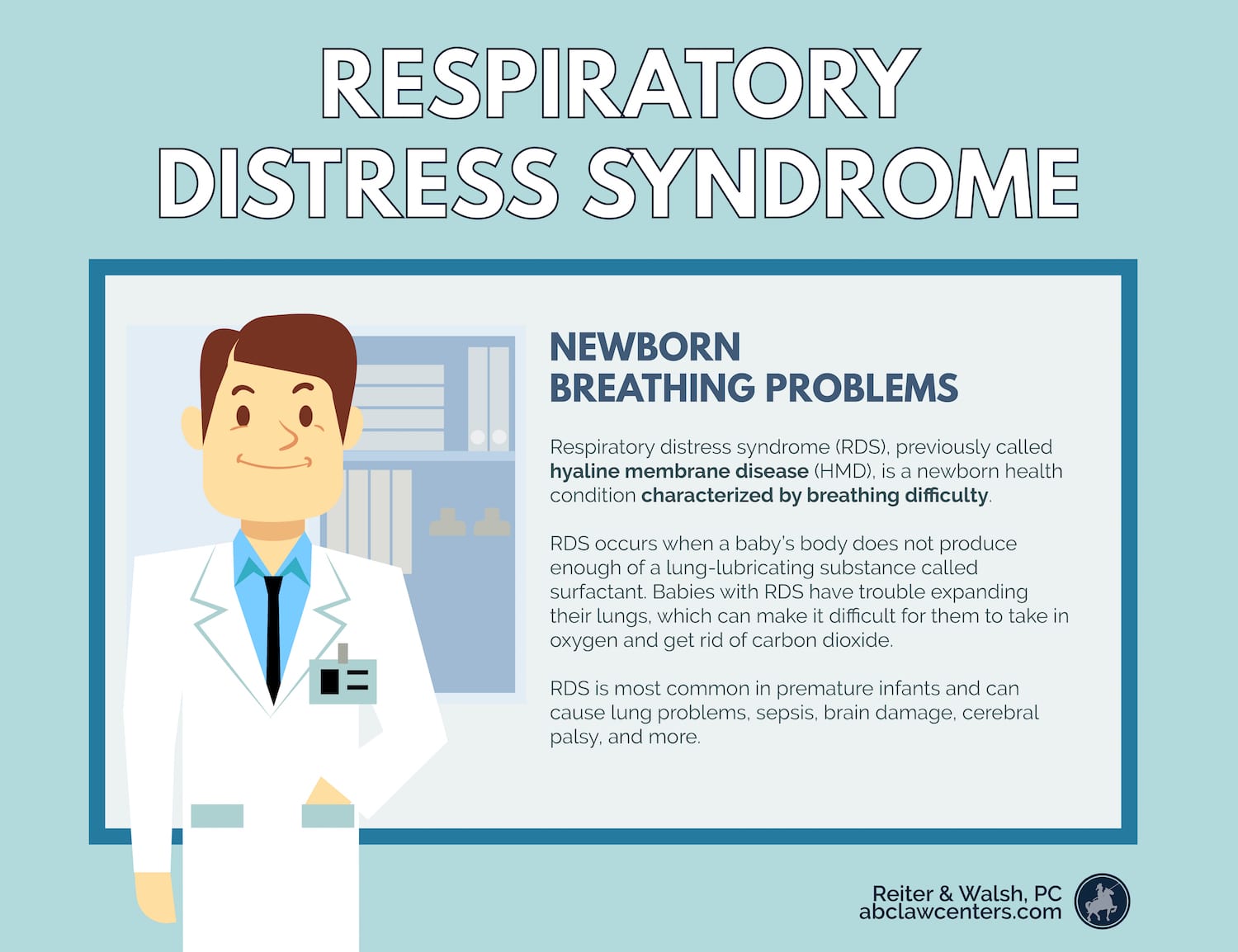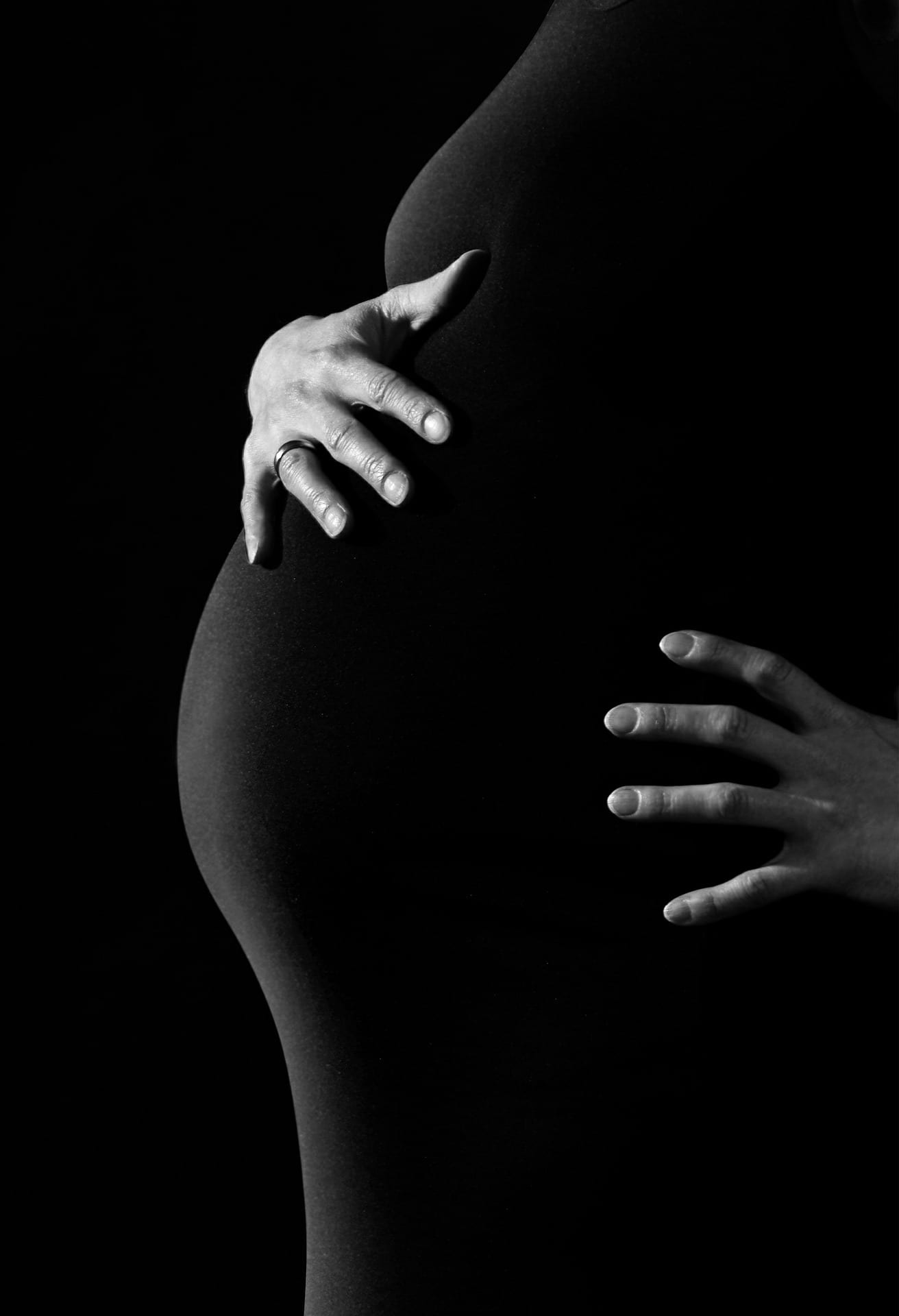Respiratory distress syndrome (RDS), previously called hyaline membrane disease (HMD), is a newborn health condition characterized by breathing difficulty. It occurs when a baby’s body does not produce enough of a lung-lubricating substance called surfactant. Babies with RDS have trouble expanding their lungs, which can make it difficult for them to take in oxygen and get rid of carbon dioxide. RDS is most common in premature infants.

Jump to:
- Causes and risk factors for respiratory distress syndrome
- Prevention of respiratory distress syndrome
- Signs and symptoms of respiratory distress syndrome
- Diagnosis of respiratory distress syndrome
- Treatment for respiratory distress syndrome
- Complications associated with respiratory distress syndrome
- Respiratory distress syndrome and medical malpractice
- Sources
Causes and risk factors for respiratory distress syndrome
RDS is uncommon in full-term babies. The more prematurely a baby is born, the more likely they are to develop RDS (1). In fact, nearly all infants born before 28 weeks gestation develop RDS (2). The reason prematurity is such an important risk factor is that premature babies’ lungs cannot produce enough of a substance called surfactant. Surfactant coats the inside of the lungs and helps them stay open. Without enough surfactant, the lungs collapse, and the infant struggles to breathe.
In addition to prematurity, genetic problems with lung development can also cause RDS. However, this is a less common cause.
Other causes and risk factors for RDS include the following:
- Maternal diabetes
- Twins/multiples pregnancy
- Delivery complications in which blood flow to the baby is restricted (1). Maternal hemorrhaging is an especially important risk factor (2)
- Rapid labor
- Having an older sibling who experienced RDS (1)
- Male sex
- Caucasian race (3)
- Infection (2)
Prevention of respiratory distress syndrome
Much of preventing RDS comes down to preventing premature birth, or providing proper medical care if premature birth is inevitable.
To prevent premature birth, it is essential that doctors provide good prenatal care. This includes checking for complications that increase the risk of premature birth, and providing medical interventions (such as a cervical cerclage or progesterone therapy) as necessary.
However, it is not always possible to prevent a premature birth, and sometimes, pregnancy complications arise that necessitate delivery via an early C-section or labor induction. If this is the case, medical professionals can do a lab test to check how developed the baby’s lungs are (1). This can help them weigh the risk of RDS and other side effects of prematurity with the risks of continuing the pregnancy.
If it is necessary to deliver early, doctors may be able to give the mother corticosteroid injections, which can help to speed up the baby’s lung development and surfactant production (1, 2).
Signs and symptoms of respiratory distress syndrome
RDS generally develops within the first 24 hours of life – most often within a few minutes or hours of birth (2). Signs and symptoms of RDS in a newborn baby include:
- Rapid breathing
- Shallow breathing
- Apnea, or brief pauses in breathing
- Nostril flaring
- Grunting sounds
- Any unusual movements while breathing (such as quickly pulling in the chest between the ribs) (1, 2)
- Cyanosis, which means that the skin and/or mucous membranes appear bluish (1)
Diagnosis of respiratory distress syndrome
Doctors can use the following tests to diagnose RDS in a newborn baby:
- Chest x-ray: The lungs of a baby with RDS will look like “ground glass.”
- Blood gas test: These can show the levels of oxygen and acid in the baby’s blood. Babies with RDS often have low levels of oxygen and excess acid.
- Lab tests: These can help to rule out infection (1).
- Echocardiography: An echocardiography uses sound waves to show heart activity. This test can be used to rule out heart defects as the cause of breathing issues (2).
Treatment for respiratory distress syndrome
An infant with RDS may be unable to breathe in enough oxygen. In order to avoid damage to the baby’s brain and other organs, doctors should give them supplementary oxygen. However, they must carefully monitor their patient’s health and be careful not to give too much oxygen. Likewise, the use of a breathing machine (ventilator) may be absolutely necessary, but it is important for doctors to be very careful not to over-ventilate the baby, which can damage lung tissue. In some cases, the use of continuous positive airway pressure (CPAP) – which helps to keep a baby’s airways open – can be used instead of a ventilator.
Babies can also be given extra surfactant. This is delivered directly into the airway, so there is some risk involved. Additional research should shed light on when the use of surfactant is appropriate, and in what amount (1).
It is also very important to address any underlying causes of RDS or other conditions that are common in premature infants, such as infection (2).
Complications associated with respiratory distress syndrome
In some cases, infants develop other medical problems caused by their RDS or by improper treatment for RDS. These complications include the following:
- Lung problems, such as:
- Atelectasis (a collapsed lung)
- Pneumothorax (when air leaks from the lung into the chest cavity)
- Hemorrhage (bleeding)
- Bronchopulmonary dysplasia (another breathing problem that affects premature babies; it may be caused by the same treatments that can be lifesaving for babies with RDS)
- Asthma
- Sepsis (infection of the bloodstream)
- Patent ductus arteriosus (PDA): This is a complication in which a fetal blood vessel, which connects a lung artery to a heart artery, fails to close after birth. This can increase blood pressure in the lung arteries and put strain on the heart.
- Necrotizing enterocolitis (a bowel disease)
- Intracranial hemorrhages (brain bleeds)
- Brain damage
- Intellectual disabilities
- Cerebral palsy (CP)
- Blindness and vision problems (2)
Respiratory distress syndrome and medical malpractice

Medical professionals have an obligation to recognize signs of respiratory distress syndrome, and carefully manage infants with this condition as well as those who are at high risk of developing it (such as premature babies). If they fail to diagnose RDS, or to provide proper treatment, this is negligence. If their negligence causes harm, it constitutes medical malpractice.
Reiter & Walsh ABC Law Centers: Birth Injury Lawyers specializes in birth injury cases: this includes incidents of malpractice that occur during pregnancy, birth, or early infancy. When mismanaged, RDS can have serious, lifelong consequences, and we are passionate about advocating for these children.
To find out if you have a case, contact our firm to speak with one of our award-winning attorneys. We have numerous multi-million dollar verdicts and settlements that attest to our success, and you pay nothing until we win your case. We give personal attention to each child and family we help, and are available 24/7 to speak with you.
Free Case Review| Available 24/7| No Fee Until We Win
Call our toll-free phone line at 866-598-5405
Press the Live Chat button on your browser
Complete Our Online Contact Form
Sources
- Neonatal respiratory distress syndrome: MedlinePlus Medical Encyclopedia. (n.d.). Retrieved August 9, 2018, from https://medlineplus.gov/ency/article/001563.htm
- Respiratory Distress Syndrome. (n.d.). Retrieved August 9, 2018, from https://www.nhlbi.nih.gov/health-topics/respiratory-distress-syndrome
- Lung Problems in the Premature Baby. (n.d.). Retrieved August 9, 2018, from https://www.healthline.com/health/pregnancy/premature-baby-lung-problems